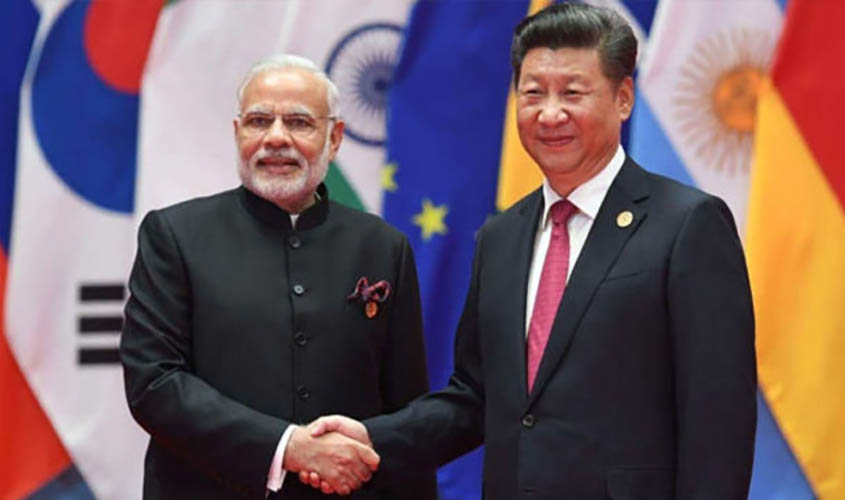With more countries pushing back against China’s aggressive policies, including Chinese President Xi Jinping’s flagship Belt and Road Initiative (BRI), and tension mounting in a rapidly deteriorating India-China relationship, Indian Prime Minister Narendra Modi and Chinese President Xi Jinping took a timely step forward with an “informal” meeting to try and arrest the decline in bilateral ties. During over eight hours of discussions spread over two days (27-28 April 2018) during which many contentious issues figured, Prime Minister Modi primarily sought to assess whether Asia’s two largest countries would be able to coexist and rise peacefully. An important consideration prompting the “informal” meeting was the reduction of tensions centring on the 73-day stand-off at Doklam, which has cast a shadow over the relationship.
It is difficult to sweep aside decades of suspicion and the pessimism occasioned by three earlier failed attempts by India to mend and build lasting ties with China. Just days before the “informal” Summit, Beijing signalled it will not dilute its support to Pakistan. Beijing called on the international community to applaud Pakistan’s record in combatting terrorism and, separately on 20 April, Chinese Defence Minister General Wei Fenghe assured the visiting Pakistan navy chief that China is “ready to provide security guarantees” for the BRI.
The wide differences that have accumulated between the two countries were reflected in their respective statements issued after the “informal” talks. Among the more important are China dropping the word “sensitivities”, used in the Indian statement, while speaking of “respecting each other’s concerns and aspirations”. The Chinese statement reiterated Chinese President Xi Jinping’s position on the Sino-Indian border enunciated in September 2014, that the border issue could be settled by successor generations, and avoided alluding to any sense of urgency. It mentioned merely that they should use “the Special Representatives’ Meeting on the Boundary Question to seek a fair, reasonable and mutually acceptable settlement”. The Indian statement, in contrast, expressed “support for the work of the Special Representatives on the India China Boundary Question and urged them to intensify their efforts to seek a fair, reasonable and mutually acceptable settlement”.
Pertinently, the Chinese statement makes no reference to any “strategic guidance” being issued to the “respective militaries to strengthen communication” as mentioned in the Indian statement and by India’s Foreign Secretary. It merely said, “The two militaries will strengthen confidence-building measures and enhance communication and cooperation to uphold border peace and tranquillity.” Obviously the reference is to the transgressions across the Line of Actual Control (LAC), but China’s statement additionally makes implicit that the political leadership has a firm grip on its armed forces. The 73-day “face-off” at Doklam appears to have loomed large in the background. Whether there is a noticeable drop in the number of intrusions across the LAC by troops of the People’s Liberation Army (PLA) will depend on the extent to which dissatisfaction—with the agreement on 28 August to “disengage” at Doklam—in sections of the PLA, the Chinese Communist Party (CCP) and the populace has dissipated. The first indicators will be the thinning of Chinese troop and weapons deployments in the area around Doklam. Positive is the decision to operationalise the “hot line”, agreed to many years ago. This will identify a “responsible” point of contact in China’s Central Military Commission to help prevent tensions escalating as during the intrusion by PLA troops in Chumar in September 2014 and earlier in the Depsang Plains in April 2013.
The Chinese media is a useful barometer of official Chinese attitudes and thinking. Just days after the Summit, on 29 April and 1 May, China’s state-run Global Times published articles critical of India which emphasised against using “any high-sounding rhetoric” for the summit, saying it “is wise to keep calm”. Maintaining China’s right to go ahead with the China Pakistan Economic Corridor (CPEC), they stressed that the “sub-continent is no one’s backyard”. Appreciating “India’s prudence in addressing Beijing’s concerns over the Dalai Lama”, one article said, “Modi strives to improve India-China relations, adjust neighbourhood diplomacy and New Delhi’s ties with other major powers, pave the way for his election politically and attract China’s investment.”
At least 39 articles on the summit and India-China cooperation were published in China’s official Chinese and English language media between 26 and 30 April 2018. Their analysis yields some interesting insights. In addition to a generally softened posture compared to recent months, they candidly acknowledge the trust deficit between the two countries, especially after the border stand-off. They praised the summit as a well planned secret strategy, which was well executed to improve bilateral ties. Describing the summit as a “great” step, China’s official media appreciated India’s “snub” to Australia in the Malabar exercises and described the summit as against American protectionist policies. One China Daily article referred to India as “a tiger” instead of an elephant and vouched that the Dragon and Tiger would work together harmoniously for the Asian century!
In the background of the summit and China’s decision to temporarily recalibrate its policy towards neighbours and India, are the warnings by influential Chinese experts that China is fast losing goodwill and friends. Relevant is Tsinghua University professor and international relations expert Jin Canrong’s observation that India has the potential to derail China’s ambitions. It will be prudent to remember that Beijing’s initiative is a temporary course correction and be cautious while dealing with China.
Jayadeva Ranade is a former Additional Secretary in the Cabinet Secretariat, Government of India and is presently President of the Centre for China Analysis and Strategy.

